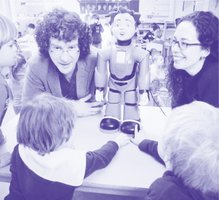

Peter-Paul Verbeek
Socializing Materiality – Mediation Theory and the Social Life of Things
How to understand the social role of things? In fields like material culture studies, design studies, and philosophy of technology this has been a central question for several decades now. Recent technological developments urge us to expand these frameworks, though. Developments like Ambient Intelligence and the Internet of Things result in an increasingly ‘environmental’ role of things. And developments in social robotics and artificial intelligence are introducing new categories of ‘social things’. In this lecture I will investigate how we can conceptualize these new types of artifacts as ‘social things’. First, I will address how they challenge existing frameworks for understanding human-technology relations. Second, I will argue that the ‘mediation approach’ – which sees things as mediators of agency and perception, rather than being social actors themselves – can offer an insightful framework to understand these new human-thing relations. Third, I will expand this approach toward the mediation of social relations. Drawing upon Merleau-Ponty’s concepts of the ‘chiasm’ (interpersonal relations are based upon reciprocity: touch implies being touched) and the ‘flesh’ (interpersonal relations presuppose a shared corporal reality of our selves), I will develop an expanded ‘postphenomenological’ account of the social dimension of materiality.

Peter-Paul Verbeek is full professor of philosophy of technology, vice dean of the Faculty of Behavioural, Management and Social Sciences, and co-director of the DesignLab of the University of Twente, The Netherlands. His research focuses on the philosophy of human-technology relations and aims to contribute to philosophical theory, ethical reflection, and practices of design and innovation. His publications include Moralizing Technology: Understanding and Designing the Morality of Things (2011) and What Things Do: Philosophical Reflections on Technology, Agency, and Design (2005).
